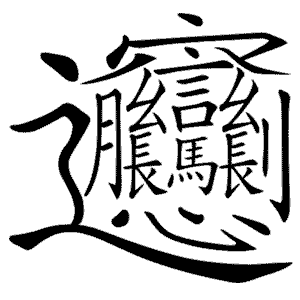
My first lesson in Chinese characters came early on – during my first day at the high school I would be working at, soon after I had come to Taiwan. All of the teachers had to be present for a morning meeting led by the principal. Like anyone on their first day on the job, I showed up on time ready to begin my new experience.
However, I soon found that since the meeting was conducted entirely in Chinese, I had to find a way to occupy the next few hours. I noticed that there was a pen and paper placed in front of each person to take notes. I also noticed a card placed in front of each person with Chinese writing on it. I asked the person next to me what was written on it, and he explained that it was my name written in Chinese – “亞當老師” (Adam Teacher).
I decided that this was the perfect opportunity to learn how to write my name in Chinese (after all, I had a few hours to kill with lots of paper in front of me to practice on). So that’s exactly what I did. By the time the meeting was over, I was pretty proud of myself as I seemed to do a reasonable job of copying my name exactly as it read on my name card.
The next day in class, I decided to impress my students by showing them that I knew how to write my name in Chinese. As soon as I had placed the chalk on the board and began my first stroke, I heard a few “wrong!” choruses from the students.
“How could this be wrong if I haven’t even finished?” I retorted. That’s when I learned my first lesson in writing characters.
Since Chinese characters were initially written with paint brushes back in the day, the order of strokes used to write the character made a big difference to what the end character looked like. Nowadays, even when using pens and pencils to write characters, it is still possible for the trained eye to tell when a character is not written properly because of the wrong order of strokes used to write it.
There are rules for stroke order. In general, top always comes before bottom, and left always comes before right. So horizontal strokes are written from left to right and vertical strokes are written from top to bottom. Where there are multiple elements like in the example picture above, there are rules for which components are written first.
Rather than memorizing these rules, I found myself a dictionary that listed the stroke order for each character. I followed this order to practice the most commonly used characters. Do this enough times and you’ll eventually find yourself automatically figuring out the stroke order for new characters just by looking at them.

Hi Adam. As I said in a previous comment, I began learning Chinese with your lessons a couple of weeks ago. For me is very important to learn how the words are written too, right at the beginning (and I think it’s also very interesting!). Do you know the site http://www.zhongwen.com/ ? It’s a kind of Chinese dictionary on-line… the really interesting thing, that I found nowere on the net, ist that they explain you how to write chinese characters (simply by clicking on the link “Animated” at the bottom of the page regarding a character). Fon instance, hier is how to write nĭ:
http://lost-theory.org/ocrat/chargif/char/c4e3.html
Thanks Alessio, that’s a great resource!